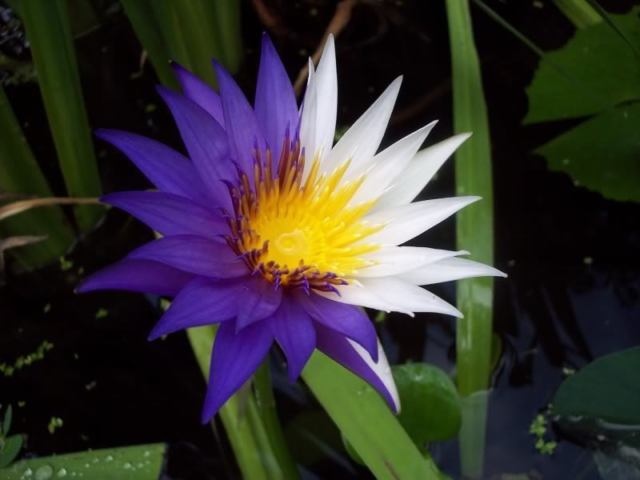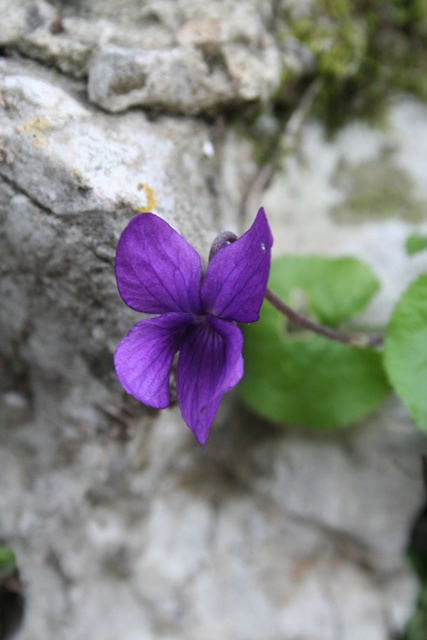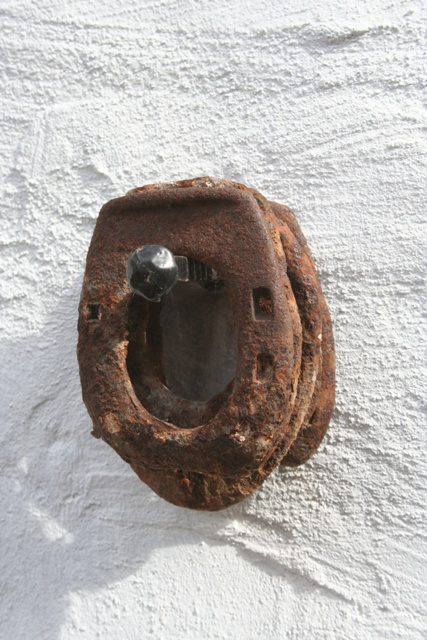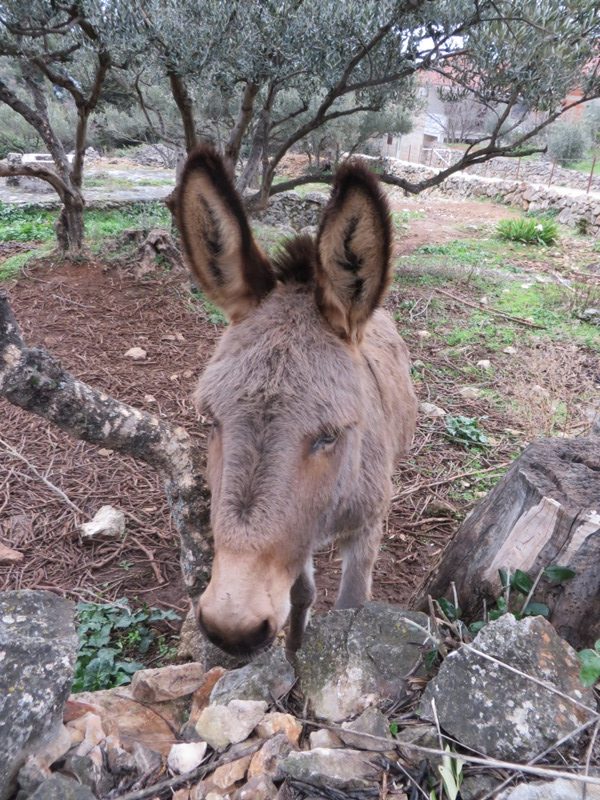Shrinking Violets
This week: Quick wins; Invasive Ivy; Shrinking Violets; Thinking cap on; Big boy’s toys; COVID-19 Preparedness;

We’re at the end of February already, today is Saturday the 29th, Leap Day so make the best of it. The next time my blog will be published on Saturday 29th February will be in twenty eight years time, on Saturday 29th February 2048.

At least this week I have not had to play ‘catch-up’ with the builders. I am back to being the master of the work programme.
It will be nice to be rid of all the building clutter and mess though. I set up my work trestles and have given the wooden door and windows frames their first coats of primer paint, in between the jacks holding up the new ceiling in the workshop.

With some rain forecast, I brought out tender bulbs from the greenhouse so they could get a good soaking. I also did some more preparation work for my pond.
Last year I bought some cuttings of various Water Lilies. They have been planted in individual pots in a 20 litre paint tub. As they have started to grow, I have transplanted them into permanent planters and moved them to a larger tub. The water wasn’t at all cold either…

Quick wins
Constantly working, day in, day out, but with little to show for your efforts can sometimes be soul destroying. Many of my jobs, both around the buildings and in the orchards are ‘long term’ projects.
Certainly nibbling away at jobs does eventually mean they are finished, but there are also a few tasks that can be completed in fairly short order.
I have several cold water stop cocks around the place. There is the master stop tap where the incoming supply leaves the water meter, but then I have added others so I can isolate water to the orchards, for example.
One such junction was inserted into the wall to isolate the cold supply to the solar water tank. The recent building activity though has rendered this stop cock almost unreachable.

Certainly in an emergency, it would be difficult to access and turn off the supply quickly. The solution was to add a new gate valve further up the supply pipe.

As the pipe has been recessed into the old stone wall, I was able to uncover it and to make a hole just large enough to get my pipe cutters into the gap.

With some accurate measuring and lots of checking, I was able to fabricate a bypass with a new stop cock. The pipe material is PP-R made by Vargon in Rijeka, but their products are sold throughout Europe and beyond.

Jointing requires pipes and fittings to be welded together using a machine to heat both ends of the Vargoterm pipes at 280º C for 12 seconds, before they are forced together.
This softens the PP-R and when pushed together the material fuses as it cools making a solid joint.
There is a comprehensive catalogue available for every domestic and commercial application possible. The joints are strong and long lasting and I think better than the solvent based piping systems I have used in the past.
When I was using the solvent type of pipe welding, I either never had the solvent, or it had gone hard and was unusable. With this system, I just bring the welder out of its box and plug it in.
With pipe insulation added, the water was turned back on and everything worked without any leaks.

In due course these pipes will also be buried in concrete, but the gate valve wheel will remain available outside the building. After just a single morning’s work, it is a quick win.
Invasive Ivy
Every home has one of these areas (some even have several!). Somewhere that is seldom visited, a place generally ignored and which is perhaps the least aesthetically pleasing location on the property.
Mine is the north boundary wall of one of my buildings. It overlooks my neighbours small, triangular vegetable plot. I have a couple of windows which overlook the plot.

This wall receives sun early in the morning and late in the evening for just 10 weeks a year, from late May until early August. This buildings has been constructed on the massive foundations of a much earlier building.
The walls on the north side are close to a meter thick at the base. They are stepped as the current building’s walls have been built on these substantial foundations.
Being north facing, the wall has always been damp. It also has been colonised by Ivy, Hedera, which has thick and twisted roots going deep into the stone work.
Over the past year I have been making strenuous efforts to get rid of the ivy because of the damage it is doing to the lime mortar between the stones.

Checking the wall on Sunday, I could see where there was new growth. The trailing Ivy tendrils were generally easy to pull away because they are new.
I was pleased to see that ferns, mosses and worts were growing where 12 months ago it had just been solid ivy.
Following current advice, I have left the older stems to die, dry and then fall off on their own. That way there is no more damage to the mortar between the stones. Then as I moved along the wall I could see a splash of colour, a vivid, vibrant purple.

Several small, purple flowers were sticking out from a crevice between stones. They weren’t there last year and I thought from a distance they might be a wild Cyclamen, growing from seed that a bird has dropped.
When I looked closely, I saw they were Sweet Violets, Viola odorata.

Examining them I could see the downward pointing hairs on the stems and there was the unmistakable fragrance of Violet.
I’ve never seen these in flower here before. In fact, I have no other examples anywhere on my land.
Shrinking Violets
Ivy here flowers late in the year, producing berries in early winter. I have some that I have yet to eradicate, which is still covered in berries. But a short walk to some abandoned land close by shows the true extent of the Ivy problem.

During the winter, when other food sources are scarce, Ivy berries provide food for a number of of bird species. I have seen Blackbirds feeding on it up right up until this week.

The seeds pass through the bird’s digestive system, to be deposited liberally across the landscape. It is from this source that I think so much of our island’s Ivy has developed.
However the Violet propagates by means of runners, or by seeds being spread by ants. Ants are another species I have huge number of so that is perhaps one way it has arrived.

The propensity of Ivy to completely smother everything that it covers would suggest that this little wild flower has not been here more than a year – from when I removed a lot of the ivy.
It will be on the move soon, to a new home in one of my shady, damp dry-stone walls, but somewhere where it can be seen and enjoyed.
There is a long runner clearly visible, waiting to find somewhere to expand into. Perhaps I should have called this section “expanding violets”?
Thinking cap on
Eeyore’s home is long gone, but he and his friends are not forgotten.

Their spirit lives on through the hitching rings outside every one of my home’s doors. These I am keeping, (I need somewhere to tie the car to, so it doesn’t wander off) together with a collection of shoes, hanging on nails.



There are a couple of Eeores’ still in the village that I hear braying most mornings, presumably because they are hungry?
The resident motor mechanic in Jelsa also has two Donkeys in his garden too, which I take carrots and apples for when I am passing.

After I carefully dismantled the donkey stable, keeping together every stone from the entrance, the builder has recreated the stone entrance as the portal into the new workshop.
This means that I will have to make my own doors to fit.
So it was “thinking cap on time” this week to draw a plan and start construction. My plan, sketched out onto an A4 page gives me the size of the opening, the size of the doors, the profile I need to cut into the frame and all relevant dimensions.

The plan might not look much, but wait until you see the doors!
No two natural stones are the same, so the curved arch is a little less than even.
I started by sticking two A2 sheets of paper together with a glue stick, and then tracing an outline of the shape of the stone curve. I then cut the paper to the outline.

This showed me that the middle stone, isn’t quite in the middle of the archway. But that’s not a problem because when I make the crossbar for the door, I can cut it to fit.
I am suing 8 x 5 cm pieces of timber for the frame and I have had them seasoning in my store for two years.
The quality of timber here is generally poor, so I now do my own seasoning. This allows timber to dry out naturally before cutting, rather than it drying and shrinking after I have built something.
After I cut the 8 x 5’s to fit, I then ran them through the thicknesser machine to give me planed, straight edges of a uniform size. With straight edges to work from, I made up the top bar and screwed it together, while I traced the outline of the arch onto the wood.

Measure three times and cut once is a very good maxim to work by. So I rechecked the pattern against the stonework and marked the compass directions, as the arch is uneven, then checked I had made the correct tracing on the timber. I had.
With the planning over, I could get down to the interesting part, of cutting the curve and the tenon joints into the timber frame.

Big boy’s toys
I have quite a few serious pieces of woordworking machinery. These are functional joinery machines rather than cabinet makers tools. The things I build out of wood need to functional and sturdy rather than ornate.
Things which are ‘sturdy’ tend to need big pieces of timber and out on abundance of caution, I over-engineer my projects just in case…
I brought out my medium table saw. The big table saw is slightly indisposed at the moment, in the old workshop. Besides which, they both make lost of sawdust and so long as the weather is fine, I like to work outside.

With the table set up without any fences, I cut the the top bar of the door frame roughly to the shape of the arch’s curve.
Table saws cut in straight lines, so it took several passes to get close to my pencil lines.
Once cut, I brought out the Band Saw and then cut the actual curve into the wooden frame, before finishing off with 100 grade sand paper on the cut faces.

With the two pieces of the the top bar screwed together again, I again checked the dimension with the paper pattern. It was correct to within one or two millimeters. As it will be nested up against the stone arch, it is as close as I will ever get.
The next job will be cutting the mortise joints. But I am waiting for the jacks to be removed first, so I can check the profile against the arch.
COVID-19 Preparedness
I have had several conversations this week with different local folk, about the COVID-19 virus.
Yes, I live on an Island. But that in itself creates difficulty because to get here, you are confined for two hours, with a six hundred or so other people, in one lounge on a very slow ferry.
Whenever I take the ferry, I am always aware of the people round about who are coughing and sneezing. There always seem to be a few of them – and this is before COVID-19.
Although I have a list of things I need from the mainland, I have decided not to make the trip for the time being.
The island of Hvar is close to Italy, with a ferry that runs to Ancona from Stari Grad and Italy is the current European virus hot-spot.
I tried to buy some hand sanitiser but after visiting all my local pharmacies, it has all been sold. Some are expecting a new delivery early next week.
So I came home from the supermarket with hand soap. Not quite what I wanted, but the best I can do.
I generally keep a week to ten days supply of food staples in the house, with just fresh veg, bread, dairy and eggs being bought more frequently. What I did do this week though is to increase my supply of tinned and dry goods to a three week supply.
This is in case we are put into a lockdown, as has happened in several Italian towns.
My supplies of course must include my felines. Risha will only eat Felix, whereas Callie and Gizmo are less fussy.
In fact as Gizmo grows he is becoming the feline food dustbin, patiently waiting until the others have finished before he polishes off what ever they leave. Then he attacks his own food bowl with gusto.
We simply do not know how this virus is going to play out. It seems to be on the brink of being declared a Pandemic and it definitely has made local people concerned.
Everyone mentions how close we are to Italy, and the first cases in the country have been linked directly to people who have recently visited the Lombardy region.
So if I need to, I can raise my drawbridge, flood the moat, lock the gates and still live well from my freezer and dry goods. I think I might miss fresh bananas though… NRC

3 Responses
Elizabeth
Hi Norman, it sounds as if you are getting on well with the build.
Leaving the ivy to die off is by far the best route. You do need to cut out a good section close to the base (about 300mm) but after that leave it to dry naturally. I do think it is a good food source for bees and birds and provides a good habitat. Once all the mortar joints are filled and sound, you could consider allowing it back. It will help insulate the building from heat and cold, as well as being a wonderful habitat. Just a thought.
You might find that the violet was just sitting waiting to be uncovered and given the right conditions and space to germinate. Seeds can be remarkably long lived.
I wouldn’t worry about the lack of sanitiser – good old soap and water and a proper hand washing routine will do as well. In fact, I have heard some people say that the sanitiser is a not always as good as soap and water. I would also suggest wearing gloves when in public places – prevents direct contact with general surfaces such as handrails and door handles that all and sundry might handle. One year, when I was at boarding school, my bedroom of eight of us, managed to avoid a sickness bug that knocked down most of the rest of the school – we think because we had our own bathroom and were effectively in isolation away from the rest of the house who had to share baths, sinks and toilet facilities.
Stay well… keep up with lots of vitamin C!
Zak
Good morning
Nice to read your emails
I hope you are always healthy and wonderfully well
Marcy Fletchall
Hello my friend, Thank you for such a great read. I loved your opening picture of the town, and the flowers. I’m on my journey to take photos and sell them, and love what you have done. You may want to look at http://www.marcyfletchallphotography.com to see some of my work.
The virus has wiped out all of our sanitizer, masks, gloves and many other items. It’s partially because people are afraid due to mixed messages of how severe the situation is. The other reason is that the supplies come from China and we are stuck without.
I hope you stay well and happy. I love all of the blogs, pictures and your explanations of the things that you do as I have no clue. I am, however, going on another journey pulling my travel trailer to complete my bucket list before I can’t. I so admire the work you do and all that you put into your property and life.
Thank you always for sharing. Stay well and safe. Warm regards,Marcy